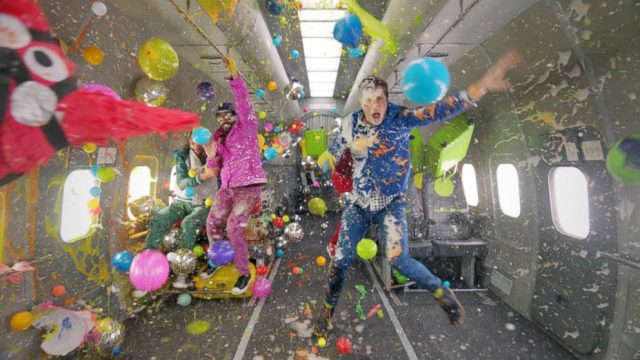Upside Down and Inside Out dir. Damian Kulash & Trish Sie, music performed by OK Go
Wheeeeee!
If there can really be said to be a blockbuster season anymore, we’re soon to enter it. There will be several movie options awash in CGI backgrounds, characters, props, and most any other onscreen element you can name. Computer-generated effects are the standard of the day and any bit of visual magic in the movies is assumed to be the result of 3D animation. Avengers behind-the-scenes photos look like people in green pajamas standing in front of a local weatherman’s map. Disney continues to re-render their back catalog as photorealistic cartoons.
As CGI came of age – roughly between 1993 when the dinosaurs of Jurassic Park marked an evolution from the past and 1999 when The Matrix demonstrated the applications of the future – the grumbles against it grew on pace. CGI is a near synonym for laziness when discussing visual effects. Even though a lot of work goes into creating good CGI, it’s the nature of the work that chaffs. Practical effects mean people building and inventing things, probably getting out their chemistry sets and their circular saws and coordinating the results with the rest of the cast and crew in real time on a set. Computer effects connote work hours spent at the computer. A lot of innovation goes into software development but that’s a lot less sexy than most anything you can make out of rubber and iron. It’s another kind of effort and one that doesn’t feel different enough from the effort we’re putting in to watch the thing.
The ubiquity and increasing seamlessness of digital effects has tarnished the wonder of effects that aren’t CGI (and rare is the effect that isn’t computer-enhanced to some degree – this is often good news for performer safety as much as aesthetics). When the answer so often is “computer animation,” the fun has disappeared from trying to backwards engineer a particularly tricky shot. So when something isn’t primarily computer-driven, it’s an opportunity for a publicity bonanza. scb0212 recently posted a link to an Assassin’s Creed promotional featurette that made pains to showcase a practical freefall stunt. Mad Max: Fury Road touted its extensive use of practical stunts and vehicles on its Oscar run.
OK Go is a band known for their videos as much or more than their music. They first went viral with the lo-fi video for their song “Here It Goes Again” where the band members performed choreography across a set of treadmills, setting up a trend of videos involving elaborate in-camera stunts (including a 24-hour time lapse performance of a single song and a mind-blowing Rube Goldberg device) whose gimmicks compliment the music in pleasing ways.
“Upside Down and Inside Out” is the finest example of this. The video is shot inside a fixed wing aircraft, designed and piloted to perform a series of dives creating periods of weightlessness during the plummet (this was also how the zero-G effects were achieved way back in Apollo 13 and, yes, it is too soon to speculate whether it served as an inspiration to Boeing engineers). Periods of downtime (when the plane is reclimbing to its apex) are hidden with cuts and morphs but always back to the same single take from the 21 total attempts. Such effort would be entertaining enough as pure spectacle, but Kulash & Sie (frequent collaborators and siblings) take pains to build from simple acrobatics to the messy climax and to match tricks with the tempo, like one lovely, quiet moment where a lonely piñata floats toward the camera.
It’s a fun video, but would it be as fun if we didn’t know it was done without wire erasure or animated disco balls? Would we assume it’s strangely imprecise CGI and register it with the same indifference as an effects-driven gum commercial? Given how blasé audiences have become about effects, it’s no wonder the opening title plays up the “real” experience. It’s not entirely a technophobic urge. It’s just practical.

